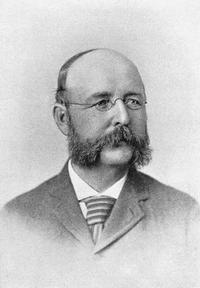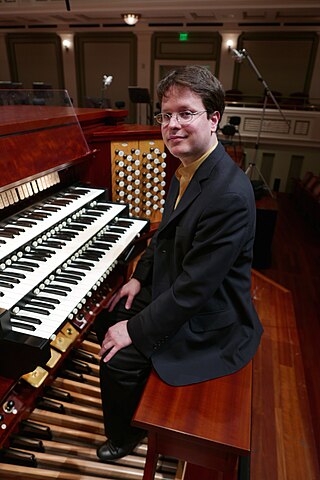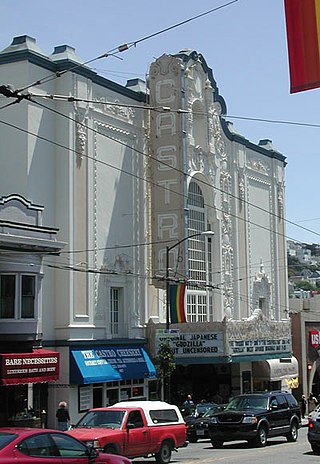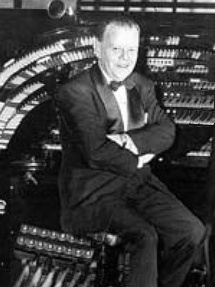
The Castro Theatre is a historic movie palace in the Castro District of San Francisco, California. The venue became San Francisco Historic Landmark #100 in September 1976. Located at 429 Castro Street, it was built in 1922 with a California Churrigueresque façade that pays homage—in its great arched central window surmounted by a scrolling pediment framing a niche—to the basilica of Mission Dolores nearby. Its designer, Timothy L. Pflueger, also designed Oakland's Paramount Theater and other movie theaters in California during that period. The theater has more than 1,400 seats.

A theatre organ is a type of pipe organ developed to accompany silent films, from the 1900s to the 1920s.

Frederik Reesen Magle is a Danish composer, concert organist, and pianist. He writes contemporary classical music as well as fusion of classical music and other genres. His compositions include orchestral works, cantatas, chamber music, and solo works, including several compositions commissioned by the Danish royal family. Magle has gained a reputation as an organ virtuoso, and as a composer and performing artist who does not refrain from venturing into more experimental projects – often with improvisation – bordering jazz, electronica, and other non-classical genres.

John Knowles Paine was the first American-born composer to achieve fame for large-scale orchestral music. The senior member of a group of composers collectively known as the Boston Six, Paine was one of those responsible for the first significant body of concert music by composers from the United States. The Boston Six's other five members were Amy Beach, Arthur Foote, Edward MacDowell, George Chadwick, and Horatio Parker.
An organ recital is a concert at which music specially written for the organ is played.
George Wright was an American musician, possibly the most famous virtuoso of the theatre organ of the modern era.

Jesse Crawford was an American pianist and organist. He was well known in the 1920s as a theatre organist for silent films and as a popular recording artist. In the 1930s, he switched to the Hammond organ and became a freelancer. In the 1940s, he authored instruction books on organ and taught organ lessons.

Paul Jacobs is an American organist. He is the first organist to receive a Grammy Award. Jacobs is currently the chair of the Juilliard School's organ department and is considered "America's leading organ performer."

Dennis James is an American musician and historic preservationist. Beginning in 1969, he presented historically informed live accompaniments for silent films, with piano, theatre organ, chamber ensemble and full symphony orchestras, throughout the United States, Canada, Mexico and overseas. He is now primarily active as a noted multi-instrumentalist, specializing on Franklin glass armonica and the theremin, prominently performing in New York at the Metropolitan Opera, for Hollywood film scorings, and repeat performances at Lincoln Center's Mostly Mozart Festival plus performing at the Tanglewood Festival with the Boston Symphony Orchestra performing the intricate glass armonica complete part in the U.S. debut of George Benjamin's opera "Written on Skin".

Edwin Henry Lemare was an English organist and composer who lived the latter part of his life in the United States. He was one of the most highly regarded and highly paid organists of his generation, as well as the greatest performer and one of the most important composers of the late Romantic English-American Organ School.
Thomas Mantle Murray is an American organist, known as an interpreter of Romantic organ music. He was a professor of Music and university organist at the Yale School of Music from 1981 until his retirement in 2019. He is also Principal Organist and Artist in Residence at Christ Church in New Haven, Connecticut.
David Carlson is an American composer.
Walt Strony is an American recording, consulting and performing organist and organ teacher, both on the theatre organ and traditional pipe organ, ranging from pizza parlors to churches and theatres to symphony orchestras.
Aivars Kalējs is a Latvian composer, organist and pianist.

An organist is a musician who plays any type of organ. An organist may play solo organ works, play with an ensemble or orchestra, or accompany one or more singers or instrumental soloists. In addition, an organist may accompany congregational hymn-singing and play liturgical music.

Martin Ellis is an American church, concert and theatre organist. He is currently the organist for Rose City Park Presbyterian Church in Portland, Oregon. He was Principal Organist and Assistant Music Director at North United Methodist Church, and Senior Staff Pianist/Organist, Staff Arranger and Orchestrator for the Indianapolis Children's Choir and Youth Chorale in Indianapolis, Indiana until August, 2014. He works with Gresham High School's Theatre Arts Department as their resident piano accompanist.
The Marr & Colton Company was a producer of theater pipe organs, located in Warsaw, New York. The firm was founded in 1915 by David Jackson Marr and John J. Colton. The company built between 500 and 600 organs for theatres, churches, auditoriums, radio stations, and homes.

The Castro Organ Devotees Association (CODA) is an American nonprofit organization dedicated to preserving and enhancing the tradition of live organ music in San Francisco's Castro Theatre. The theater is a popular San Francisco movie palace, built in the 1920s, which gained Historic Landmark status in 1976. The original Robert Morton organ was removed in the 1950s. The present organ, widely regarded as one of the finest theatre organs assembled, was assembled in the late 1970s using components from other organs, including its console, which was originally built in 1925 for the State Theatre in Detroit, Michigan to accompany silent pictures. The current console and organ were built by the Taylor family starting in 1979, and it has been owned and maintained by them since, but in 2014 they moved taking the console and one fourth of the pipework.
The Organ Grinder Restaurant was a Portland, Oregon pizzeria in operation from 1973 to 1996. At one point it housed the largest theater pipe organ of its type in the world.

Richard William "Dick" Leibert was an American musician who was the chief organist at New York City's Radio City Music Hall between 1932 and 1971. He also had a radio program of organ music on the NBC Radio Network in the 1930s and 1940s, along with making phonograph recordings on the RCA Victor and Westminster Records labels.


















